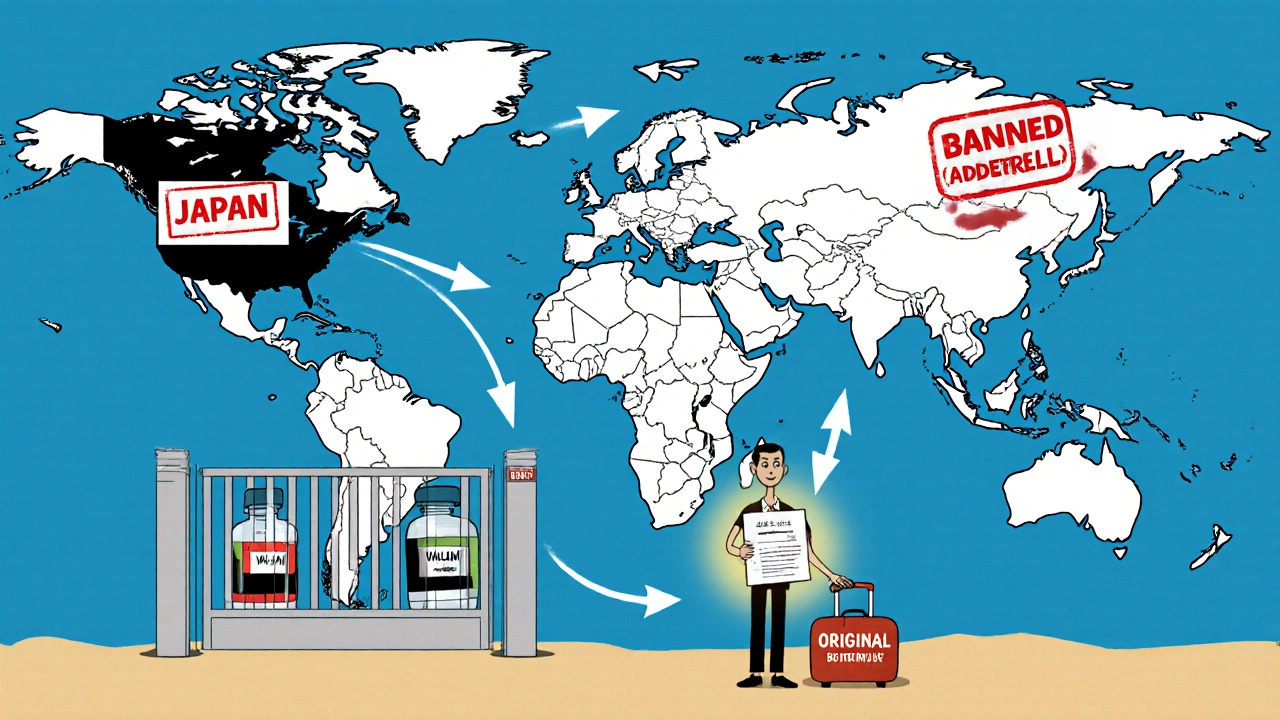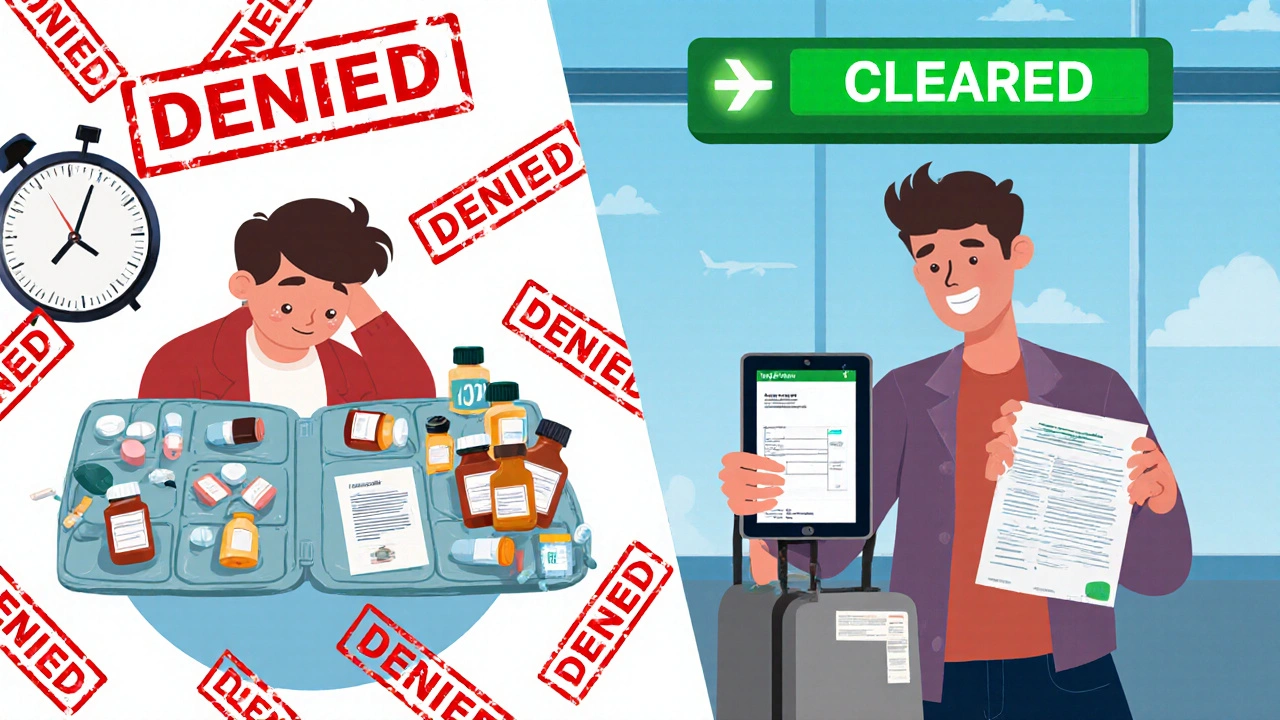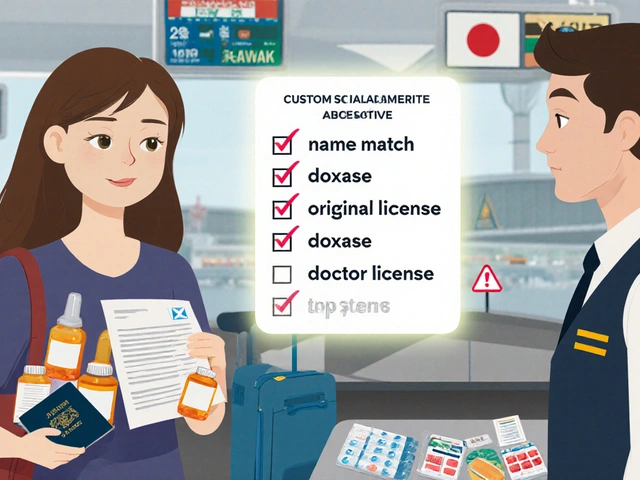Carrying controlled medications across borders isn’t just about packing your pills. One wrong step-like forgetting a doctor’s letter or packing pills in a generic bottle-and you could face hours of delays, confiscation, or worse. In 2024, controlled medications travel issues caused over 1.2 million hours of global travel delays, according to the International Air Transport Association. Most of these aren’t from people trying to smuggle drugs. They’re from travelers who didn’t know the rules.
Why a Doctor’s Letter Isn’t Optional
If you’re taking something like oxycodone, Adderall, Xanax, or even zolpidem, you’re carrying a controlled substance. These aren’t just prescription drugs-they’re regulated under international treaties. The U.S. DEA, FDA, and agencies worldwide treat them differently than aspirin or insulin. A simple letter from your doctor can mean the difference between a smooth checkpoint and a detention room. The CDC reports that 78% of confiscated medications had incomplete or missing documentation. That letter needs to include:- Your full name (must match your passport)
- Generic and brand names of each medication
- Dosage strength and how much you take daily
- Reason for use (e.g., ADHD, chronic pain, anxiety)
- Prescribing doctor’s name, license number, phone, and clinic address
- Duration of your trip and total quantity you’re carrying
What Countries Ban or Limit Your Meds
Not all countries treat medications the same way. What’s legal in the U.S. might be illegal in Japan, the UAE, or Singapore.- Japan: Adderall, Ritalin, and even some ADHD meds are banned. You need a Yakkan Shoumei import certificate-apply at least 7 days before travel. Failure to get one can mean arrest.
- United Arab Emirates: Zolpidem (Ambien), diazepam (Valium), and codeine are controlled narcotics. Even a 30-day supply without prior approval can land you in jail.
- Australia: Schedule 8 drugs (like oxycodone) require pre-approval from the Therapeutic Goods Administration. Apply online-it takes 10-15 days.
- United Kingdom: Up to three months’ supply is allowed with a valid prescription, but narcotics require a Controlled Drug Import Certificate.
- United States: Foreign travelers can bring a 90-day supply for personal use, but anything beyond that needs FDA approval.
How to Pack Your Medications Right
Never repack your pills into daily pill organizers unless you’re carrying backup doses. Customs agents see unlabeled pills as suspicious-even if they’re yours.- Keep all medications in their original pharmacy bottles with clear labels.
- Bring a printed copy of your prescription, even if you have a digital version.
- Carry your doctor’s letter in your carry-on, not checked luggage.
- Bring a little extra-just in case your flight is delayed or you need to extend your trip.
- Don’t mix medications from different prescriptions in one bottle.

What Happens at the Airport or Border
At most international airports, you’ll be asked if you’re carrying medication. Say yes. Don’t wait to be asked. If you’re flagged, stay calm. You’re not in trouble-you’re just being processed. Here’s what usually happens:- You show your doctor’s letter, prescription, and original bottles.
- Customs checks the quantities against your trip length.
- They verify the doctor’s license number (they can call the clinic).
- If everything matches, you’re cleared in under 15 minutes.
When to Start Preparing
Don’t wait until the night before your flight. Some countries require applications weeks in advance.- Start 6-8 weeks before departure.
- Book a doctor’s appointment to get the letter. Ask if they can sign it on official letterhead.
- If traveling to Japan, apply for the Yakkan Shoumei immediately after getting your letter. Processing takes 7-10 business days and costs about $50.
- For Australia, submit your TGA application online as soon as you have your prescription.
- Use a certified translator if your prescription isn’t in English. Translation costs $25-$75, but it’s cheaper than being denied entry.

What’s Changing in 2025
The rules are tightening, but tools are improving.- The FDA is testing a new mobile app called “Traveler Medication Pre-Clearance.” If you submit your documents before you fly, you’ll get a digital approval code. Pilot programs at Chicago and Miami reduced processing time by 65%.
- The EU’s Electronic Prescription Service lets travelers access digital copies of prescriptions through the EU Digital Health Certificate. This is rolling out across 27 countries.
- The International Narcotics Control Board is working on a standardized international medication certificate. It’s expected to launch in 2026 and will be accepted in 32 pilot countries.
What to Do If You’re Denied
If your meds are seized or you’re denied entry:- Ask for a written explanation. You have the right to one.
- Contact your country’s embassy immediately. They can’t get your meds back, but they can help you navigate legal options.
- Don’t argue. Stay calm. Being hostile won’t help.
- Ask if you can send the medication back to your doctor or pharmacy. Some countries allow it.
Can I bring my controlled medication in my checked luggage?
No. Always carry controlled medications in your carry-on. Checked bags can be lost, delayed, or opened without your knowledge. If customs needs to inspect your meds, you need to be there to explain them. Keep your doctor’s letter and prescriptions with you at all times.
Do I need a letter for over-the-counter meds that contain pseudoephedrine?
Yes. Pseudoephedrine is a precursor chemical used in illegal drug production. Even though it’s available over-the-counter in the U.S., countries like Japan, Canada, and Australia treat it as a controlled substance. Bring a doctor’s note explaining why you need it, especially if you’re carrying more than a 3-day supply.
What if my doctor won’t write a letter?
Call your pharmacy-they often have templates doctors use. If your doctor still refuses, visit a travel medicine clinic or urgent care center. Many offer this service for a small fee. Your health and safety are worth the cost.
Can I mail my medication ahead of time?
Generally, no. The FDA and most countries consider personal shipments of controlled substances as commercial unless they’re from a licensed pharmacy to a licensed prescriber. Mailing your meds risks confiscation, fines, or criminal charges. Always carry them with you.
Is there a limit to how much I can bring?
Yes. Most countries allow a 30- to 90-day supply for personal use. For Schedule II drugs like oxycodone, the DEA limits travelers to 50 dosage units without special authorization. Always check your destination’s rules. Bringing a 6-month supply-even with a letter-can trigger suspicion of intent to distribute.


Bart Capoen
October 29, 2025 AT 13:07just brought my Adderall to thailand last year and they didnt even blink. original bottle, doctor letter, and i told em i needed it for focus. chill vibes. dont overthink it
Bob Martin
October 29, 2025 AT 22:51lol the fact that you need a 500-word letter just to carry your own medicine is insane. we live in a world where your body is a crime scene and your prescriptions are evidence. the FDA could’ve just said ‘dont be an idiot’ and saved us all 2 hours of paperwork
Kevin Stone
October 30, 2025 AT 20:00you think this is bad? try flying into japan with a 90-day supply of oxycodone and no yakkan shoumei. i watched a guy get detained for 14 hours because his doctor wrote ‘pain’ instead of ‘chronic lower back pain due to degenerative disc disease.’ customs doesn’t care about your suffering-they care about bullet points.
Gary Fitsimmons
November 1, 2025 AT 13:09i get it, rules are rules. but this system feels like punishment for being sick. you’re not smuggling, you’re just trying to survive. if your meds are in the original bottle with a doctor’s note, you deserve to get through without being treated like a criminal. keep your head down, stay calm, and you’ll be fine
Natalie Eippert
November 3, 2025 AT 06:23if you can’t follow basic rules then don’t travel. this isn’t complicated. original bottle. doctor letter. no excuses. america thinks it’s above the law but the rest of the world doesn’t care about your ‘personal freedom’ when you show up with unlabeled pills
Sage Druce
November 4, 2025 AT 19:35you’re not alone. i’ve flown with anxiety meds to 17 countries. every time i print the letter, pack the bottle, and smile at customs. it’s not about being perfect-it’s about being prepared. you got this. you’re not a threat. you’re a human trying to live
Patrick Dwyer
November 6, 2025 AT 12:55the international standardization effort by the INCB is a step in the right direction. currently, the fragmentation of regulatory frameworks creates unnecessary friction in global mobility. harmonizing documentation protocols under a unified digital credential would reduce non-compliance by an estimated 63% based on preliminary data from the 2023 WHO Travel Health Survey
Tyler Mofield
November 6, 2025 AT 13:15the current regulatory architecture governing the transnational transport of scheduled pharmaceuticals is predicated upon the principle of sovereign control over psychotropic substances as codified under the Single Convention on Narcotic Drugs, 1961. failure to adhere to the prescribed evidentiary standards constitutes a prima facie violation of international treaty obligations and may trigger extradition protocols under mutual legal assistance treaties
kendall miles
November 7, 2025 AT 01:35they’re using this to track you. every letter, every prescription, every barcode-they’re building a global pharmaceutical surveillance network. next they’ll scan your blood for meds before boarding. they don’t care if you’re sick. they care if you’re controlled. you’re just a data point now
luna dream
November 7, 2025 AT 18:45you ever wonder why the FDA is pushing this app now? it’s not for you. it’s so they can flag your meds before you even leave your house. your anxiety isn’t medical-it’s a threat to the system. they want to know what you’re taking, when, and why. and they’ll never tell you why they need to know
Jen Taylor
November 9, 2025 AT 05:26just got back from Bali-I had my Adderall in the original bottle, printed prescription, doctor’s letter on letterhead, and even a translated copy of my diagnosis from my psychiatrist. I showed everything before they asked. They smiled, said ‘thank you,’ and waved me through. It’s not about fear-it’s about clarity. Be the person who makes their job easier, not harder.
Linda Patterson
November 9, 2025 AT 18:30if you’re taking Adderall and you’re not a student or a corporate drone then you’re abusing it. the system isn’t broken-it’s protecting society from people like you who think their brain chemistry is more important than national security. you don’t need meds to function-you need discipline